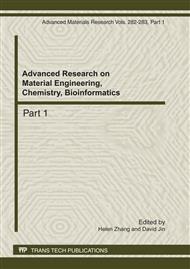[1]
Chaum D. Blind signatures for untraceable payments. In Advances in Cryptology: Proceedings of Crypto'82. NewYork: Prenum Publishing Corporation (1983), pp.199-204.
DOI: 10.1007/978-1-4757-0602-4_18
Google Scholar
[2]
D. Pointcheval, J. Stern. Security arguments for digital signatures and blind signatres. Journal of Cryptology, Vol. 13(3) (2000), pp.361-396.
DOI: 10.1007/s001450010003
Google Scholar
[3]
Jingwei Liu, Rong Sun and Weidong Kou. Fair e-payment protocol based on simple partially blind signature scheme. Wuhan university Journal of Natural Sciences. Vol. 12(1) (2007), pp.181-184.
DOI: 10.1007/s11859-006-0287-7
Google Scholar
[4]
B. V. Solms and D. Naccache, On blind signatures and perfect crimes. Computers and Security, Vol. 11(6) (1992), pp.581-583.
DOI: 10.1016/0167-4048(92)90193-u
Google Scholar
[5]
M. Abe and E. Fujisaki. How to date blind signatres. In ASIACRYPT'96, LNCS 1163, Springer -Verlag, (1996), pp.244-251.
Google Scholar
[6]
Abe, M., and T. Okamoto. Provably secure partially blind signatures. In Advances in Cryptology: CRYPTO2000, Lecture Notes in Computer Science, Springer-Verlag, Berlin, Vol. 1880 (2000), p.271–286.
DOI: 10.1007/3-540-44598-6_17
Google Scholar
[7]
Zheng Gong, Xiangxue Li and Kefei Chen. Efficient partially blind signature scheme with provable security. COCOON 2006, LNCS 4112, Springer-Verlag (2006), pp.378-386.
DOI: 10.1007/11809678_40
Google Scholar
[8]
Q. Wu, W. Susilo, Y. Mu et al. Efficient partially blind signature scheme with provable security. ICCSA 2006, LNCS 3982, Springer-Verlag, Berlin (2006), pp.345-354.
DOI: 10.1007/11751595_38
Google Scholar
[9]
X. Chen, F. Zhang and S. Liu. ID-based restrictive partially blind signatures. Journal of System and Software, 80(2) (2007), pp.164-171.
DOI: 10.1016/j.jss.2006.02.046
Google Scholar
[10]
C. P. Schnorr. Efficient signature generation by smart cards. J. Cryptology, 4 (1991), pp.161-174.
DOI: 10.1007/bf00196725
Google Scholar
[11]
C. Schnorr. Security of blind discrete log signatures against interactive attacks. ICICS 2001, LNCS 2229, Springer-Verlag, (2001), pp.1-12.
DOI: 10.1007/3-540-45600-7_1
Google Scholar


